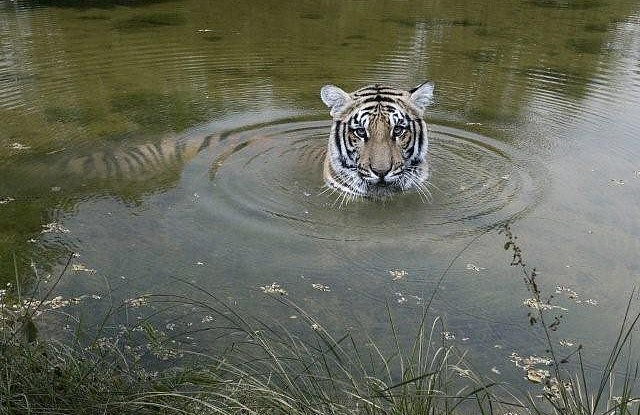BOGOR, Indonesia (25 October, 2012)_There is intense ongoing debate in the scientific literature about whether ‘land sharing’ or ‘land sparing’ is the best way to maintain global biodiversity. The ‘land sparing’ proponents argue that the most effective way to conserve biodiversity is to further intensify agricultural production on the most fertile lands so that other land can then be set aside for wildlife.
Advocates of the ‘land sharing’ approach claim that the emphasis should be on wildlife-friendly and sustainable land use practices that limit pesticide use and manage diversified farmland, to maintain biodiversity and produce food and wood in an increasingly crowded world.
Although there are many dimensions of biodiversity and thus many ways to measure it, research suggests that top predators play a fundamental role in regulating ecosystems and that their presence is associated with higher general biodiversity. A key question for the ‘land sharing’ proponents is whether sharing land between humans and top predators is even possible.
A key question for the ‘land sharing’ proponents is whether sharing land between humans and top predators is even possible.
A recent paper by Carter et al in the Proceedings of the National Academy of Sciences, answers this question by examining the ability of tigers to coexist with humans inside and outside of Nepal’s Chitwan National Park. Tigers are an interesting species to study in this context because they are globally endangered and are thought to be especially vulnerable to extinction owing to competition with humans for space and food and because of poaching pressures.
Chitwan National Park is a flagship reserve that has received extensive financial support from both the Government of Nepal and the World Wide Fund for Nature. It is also actively patrolled by the Nepalese Army to deter illegal activities. Tiger density is known to be high within the park, but the park is also surrounded by relatively dense human settlement (over 200 people per square km). This makes it an ideal place to study whether human–top predator ‘land sharing’ is really possible.
Carter and colleagues used data from motion-detecting field cameras inside and outside Chitwan Park in 2010 and 2011. Not only was tiger density quite high in both years, but remarkably, the density was not significantly different inside and outside the park. Although there were higher numbers of humans outside the park, their presence inside the park was still substantial; overall, humans triggered 85% of the cameras.
The researchers themselves were surprised to find that neither humans on foot (mostly collecting forest resources) nor those in vehicles (mostly army personnel) had a statistically significant effect on the probability of tiger presence. While 20% of tiger detections in the park occurred during daylight hours, only 5% of tiger detections outside the park occurred at those times. Thus the researchers believe that the tigers adjust their temporal activities in response to human presence by being less active when local residents are more active.
It appears that it is at least possible for humans and some top predators to share land quite effectively.
The findings of this study are very encouraging with important implications for the land sharing/sparing debate: it appears that it is at least possible for humans and some top predators to share land quite effectively. If top predators are good indicators of biodiversity, then it may not be necessary to resettle local populations and severely restrict all of their activities in order to conserve species like tigers.
Of course, the results of this study need verification elsewhere to draw more generally-applicable conclusions. There are some reasons to think that the Chitwan case may be a best-case scenario. Chitwan receives exceptional levels of financial, political, and technical support, making it quite different from many of the world’s national parks, particularly those in developing countries. In addition, not all predators are able to adjust their temporal behavior as efficiently as tigers.
Also, the paper does not discuss whether there were incidences of tiger predation on humans or their livestock, which can affect human willingness to share land with top predators. Nevertheless, the results of this study offer hope to those who believe that coexistence between humans and a top predator is at the very least possible.
We want you to share Forests News content, which is licensed under Creative Commons Attribution-NonCommercial-ShareAlike 4.0 International (CC BY-NC-SA 4.0). This means you are free to redistribute our material for non-commercial purposes. All we ask is that you give Forests News appropriate credit and link to the original Forests News content, indicate if changes were made, and distribute your contributions under the same Creative Commons license. You must notify Forests News if you repost, reprint or reuse our materials by contacting forestsnews@cifor-icraf.org.
Further reading
- Coexistence between wildlife and humans at fine spatial scales.
- Food security: the challenge of feeding 9 billion people.
- The shrinking ark: patterns of large mammal extinctions in India.
- The agroecological matrix as alternative to the land-sparing/agriculture intensification model.
- Reconciling food production and biodiversity conservation: land sharing and land sparing compared.
- Conservation: Top predators and biodiversity.
- Global food security, biodiversity conservation and the future of agricultural intensification.
- Land sharing or land sparing? Reconciling agriculture and biodiversity conservation
